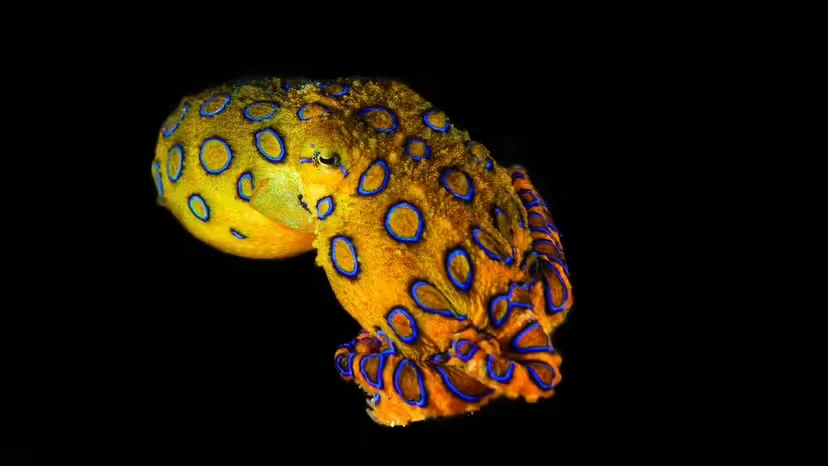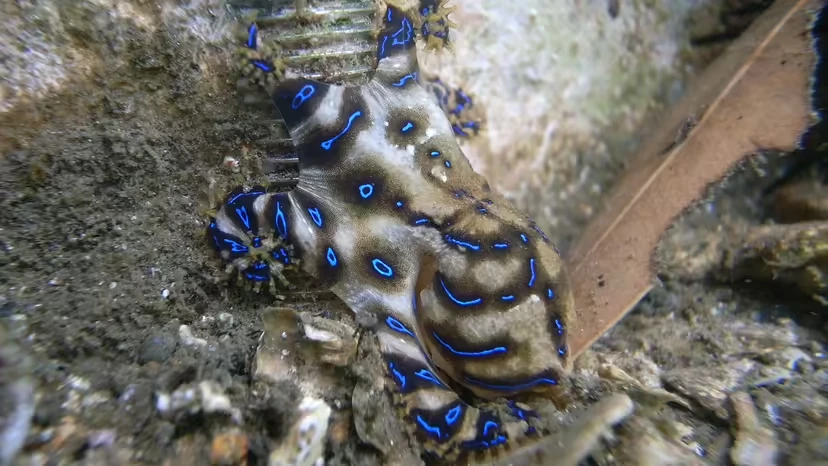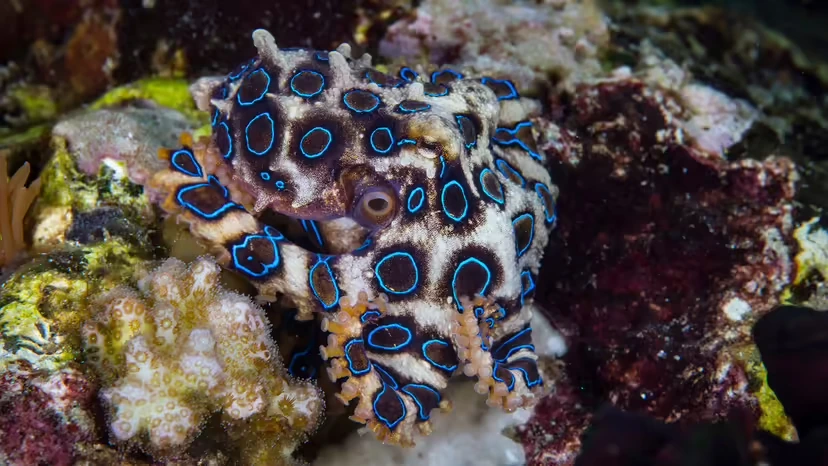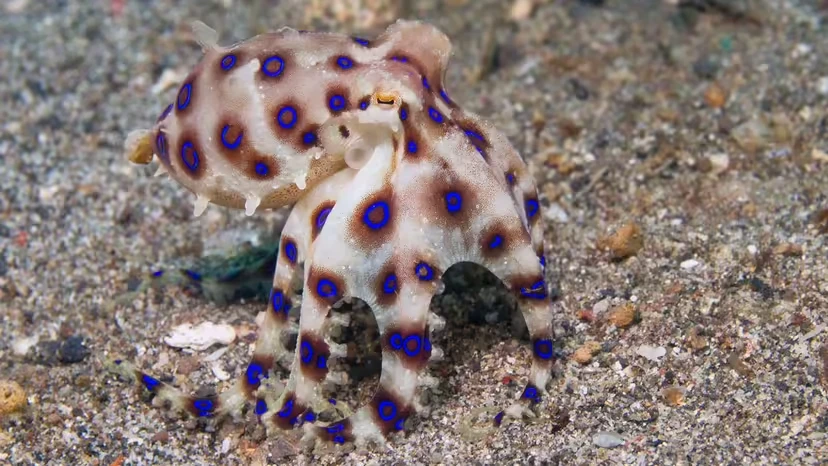Quick facts
About golf-ball sized (some even coin-sized), yet packs tetrodotoxin (TTX)—a nerve poison ~1,000× stronger than cyanide.
When stressed, its skin flashes electric blue rings/lines as a high-contrast warning.
Lives in shallow reefs, tide pools, and sand–silt flats across the Indo-Pacific (Australia to Japan/Korea).
Diet: small crabs and shrimp; lifespan ~2 years; shy and mostly nocturnal.
Human bites are rare but can shut down breathing within minutes; no antivenom exists—airway and ventilation save lives.

Range: Indo-Pacific—Australia, Indonesia, Philippines, Solomon Islands, Japan, South Korea.
Habitat: crevices, shells, rubble in tide pools and coral shallows; hides by day, forages or mates at night.
Look: yellowish to tan base color; when alarmed, iridescent blue rings or lines blaze into view.

Tetrodotoxin (TTX)
Mode of action: blocks voltage-gated sodium channels, halting nerve signaling → flaccid paralysis.
Targets: doesn’t directly stop the heart, but paralyzes the diaphragm and breathing muscles, causing hypoxia.
Origin: produced by symbiotic bacteria in the salivary glands (the animal doesn’t make it itself). Remarkably, even embryos/larvae carry TTX, so the exact acquisition and transmission pathway remains an active research topic.
Important: The octopus is reclusive and gives a visible warning display first. Most incidents stem from handling or provocation.
Onset & course
Within minutes: numb lips/fingers, dizziness, blurred or double vision, slurred speech, swallowing difficulty → generalized weakness → respiratory failure.
Conscious but paralyzed is common (the person may be awake yet unable to move or speak).
Symptoms can last 12–48 hours. There is no antivenom.
First-response checklist (beach/boat)
Call emergency services immediately.
Stop contact—avoid further handling.
Airway first: if breathing is weak or absent, start rescue breaths (mouth-to-mouth or bag-valve mask) without delay.
Monitor continuously (breathing, pulse, responsiveness).
Immobilize the limb and limit movement. (If you’re not trained in pressure-immobilization for neurotoxins, prioritize ventilation above all.)
Maintain assisted ventilation until EMS provides oxygen and mechanical support.
TTX block is reversible with time. Ventilation buys survival until the toxin wears off.
Prey: shrimp when young; later small crabs/prawns roughly head-sized or smaller.
Tactics:
Injection: leap on the prey’s back, crack the shell with the beak, inject TTX-laden saliva.
Clouding: release a toxin-containing plume near the prey so it’s taken in through gills.
Large crabs can injure them, so blue-ringed octopuses typically avoid high-risk targets.

Confirmed members of the blue-ringed octopus genus include:
Greater blue-ringed octopus (H. lunulata): slightly larger; planktonic larval phase → wider dispersal.
Southern (lesser) blue-ringed octopus (H. maculosa): hatch as miniature adults → crawl-based dispersal; more localized.
Blue-lined octopus (H. fasciata): vivid blue lines rather than rings; equally potent.
H. nierstraszi (rarely observed).
Takeaway: Don’t rely on “rings only” for caution—blue lines can signal the same danger.
Look, don’t touch. Never pick up small octopuses, shells with animals inside, or probe holes with bare hands.
Wear reef shoes/gloves; if you lift a rock, set it back gently as found.
While snorkeling/diving, don’t reach into crevices.
No home aquariums: don’t collect or keep wild blue-ringed octopuses.
Teach kids a simple rule: “Blue rings/blue lines = hands off.”

Do they attack people?
Rarely. They’re shy and typically display their warning rings/lines first. Most bites follow handling.
Are bites always fatal?
Not if airway and breathing are supported promptly. Many patients fully recover with timely ventilation.
Any antidote?
None currently in clinical use. Treatment is supportive care (oxygen, ventilation) until the block resolves.
How can I tell it’s a blue-ringed species?
The sudden, neon-blue rings or lines when agitated are a strong clue—but do not approach to confirm.
The blue-ringed octopus is a masterclass in “small yet supreme”: tiny body, blazing warning colors, and world-class neurotoxin. Give it space and respect, and your risk is close to zero. If a bite occurs, airway and assisted breathing—fast—are what turn minutes into survival. It’s one of the ocean’s most extraordinary animals to admire—from a safe distance.
animal tags: blue ringed octopus
We created this article in conjunction with AI technology, then made sure it was fact-checked and edited by a Animals Top editor.